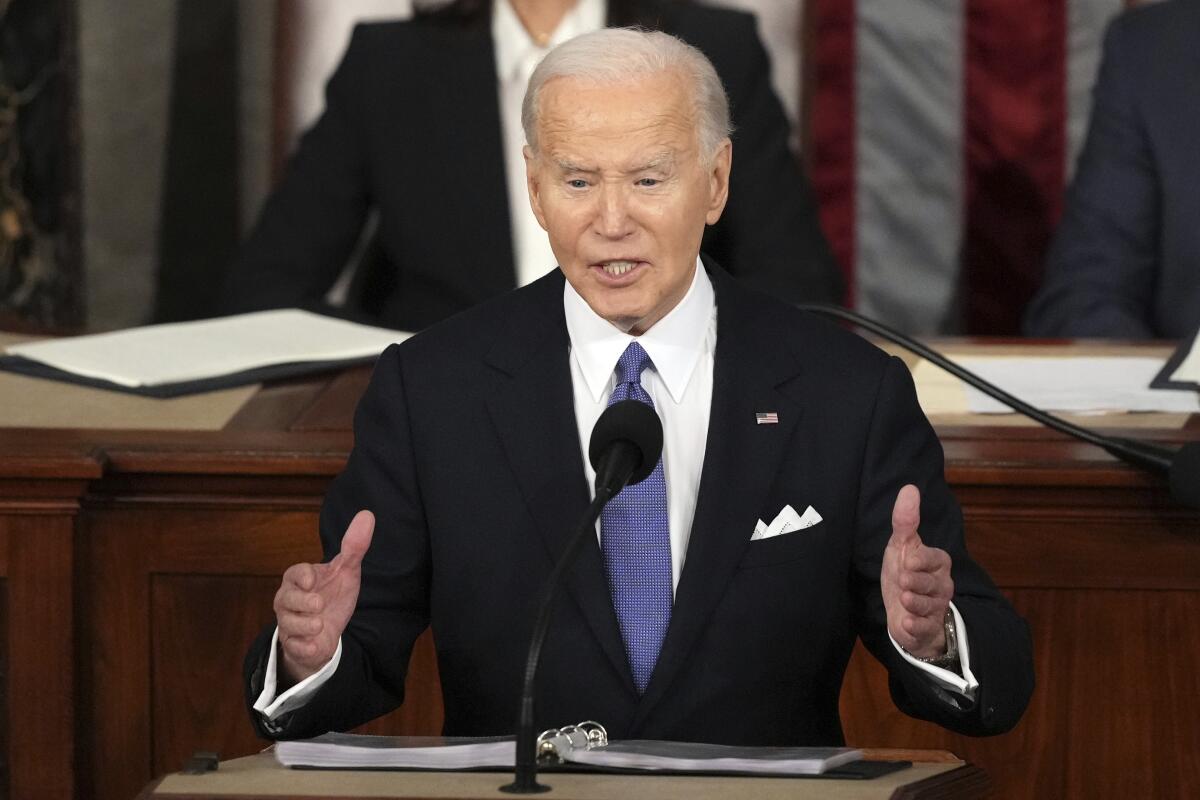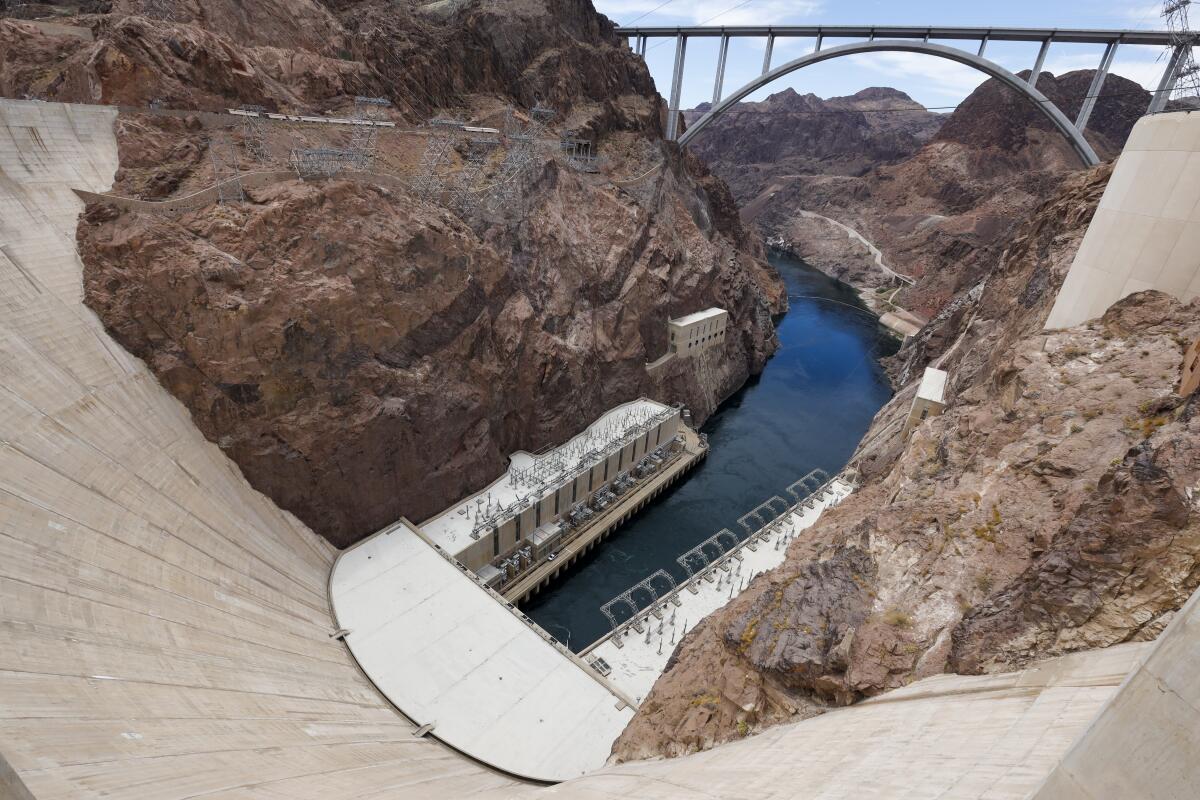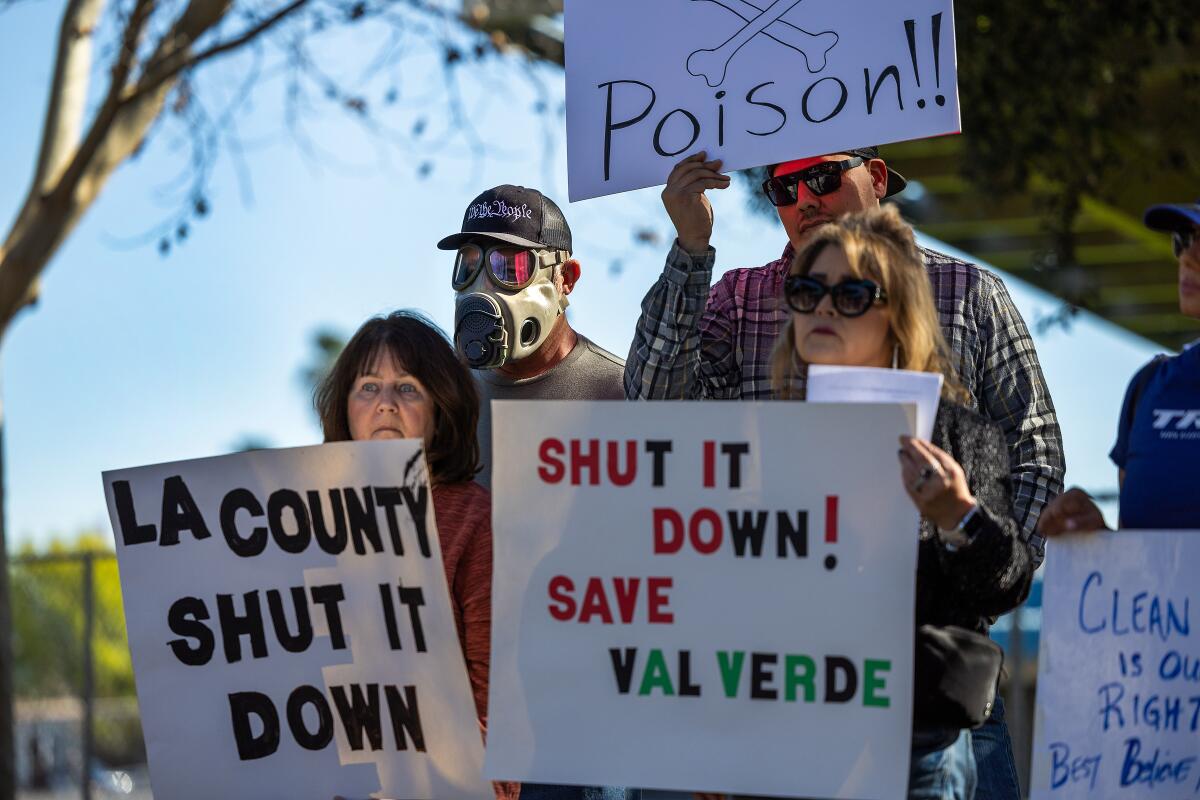Column: Biden’s State of the Union address should give us hope on climate

- Share via
If I were a pessimist, I might start today’s newsletter by telling you that Earth just wrapped up its ninth straight month of record-breaking temperatures.
Indeed, the planet’s warmest June, warmest July, warmest August, warmest September, warmest October, warmest November, warmest December and warmest January ever recorded were followed by its warmest February ever recorded too, according to European Union scientists. My L.A. Times colleague Hayley Smith has the details.
Or, continuing on the pessimism front, I could tell you about new research predicting that the Arctic Ocean could see its first ice-free days within the current decade — i.e., before 2030. Again, Hayley has the story.
But I’m not a pessimist. So instead I’ll start with President Biden’s State of the Union address last week, in which the president surprised me by touting a bunch of his administration’s clean energy accomplishments and promising more to come.
“I’m cutting our carbon emissions in half by 2030; creating tens of thousands of clean energy jobs, like the IBEW workers building and installing 500,000 electric vehicle charging stations; conserving 30% of America’s lands and waters by 2030; and taking action on environmental justice — fenceline communities smothered by the legacy of pollution,” Biden said.
You're reading Boiling Point
Sammy Roth gets you up to speed on climate change, energy and the environment. Sign up to get it in your inbox twice a week.
You may occasionally receive promotional content from the Los Angeles Times.
To be fair, those accomplishments are all works in progress.
The nation’s heat-trapping carbon pollution fell slightly last year, but not nearly enough to meet Biden’s goal of cutting emissions in half by 2030. Those half-million EV charging stations are only a glint in the president’s eye — and we’ll ultimately need a lot more. Protecting 30% of America’s lands and waters by 2030? It’s a great idea known as “30 by 30” that we’re still far from reaching. And as for environmental justice? Easy to preach, not always so easy to implement.
But at least Biden is saying the right things on climate change, and frequently doing them. Unlike his predecessor and soon-to-be challenger for the White House, former President Trump.
From a climate perspective, the highlight of the State of the Union was probably his discussion of Belvidere, the Illinois city where the car company Stellantis shut down a giant assembly plant — only to later agree to invest billions of dollars in reopening the facility through a deal struck with the United Auto Workers union. As part of the deal, Stellantis will agreed to build an electric vehicle battery plant at the site, expected to create 1,300 additional jobs.
Biden cited Belvidere as an example not only of the power of unions, but of the clean energy investments driven by the legislation he has signed, including the Inflation Reduction Act (a.k.a. the climate bill) and the bipartisan infrastructure law.
“My policies have attracted $650 billion in private-sector investment in clean energy, advanced manufacturing, creating tens of thousands of jobs here in America,” Biden said.
“And, by the way, I noticed some of you who’ve strongly voted against it are there cheering on that money coming in. And I like it. I’m with you. I’m with you,” the president added, speaking directly to congressional Republicans who voted against those laws.
None of it is enough. But that shouldn’t stop us from nodding along, before we go back to demanding more.
“I see a future where we save the planet from the climate crisis,” Biden told viewers.
I see that future, too. I’m an optimist, after all.
On that note, here’s what’s happening around the West:
TOP STORIES

After a wet winter, it seems unlikely that the West’s largest reservoirs, Lake Mead and Lake Powell, will crash in the next few years. But the Colorado River’s long-term challenges remain the same. My L.A. Times colleague Ian James has the details on the climate-fueled risks facing the river. Ian also talked with representatives for the river’s upper and lower basin states, who just filed competing plans for the long-term cutbacks that will be needed to ensure a sustainable future. In other intriguing news, San Diego County is looking into desalinating even more Pacific Ocean water — if other parts of the West looking to use less Colorado River water are willing to pay for it. Voice of San Diego’s MacKenzie Elmer wrote about that intriguing possibility.
In theory, all the snow and rain mean these last few months we shouldn’t expect too bad a wildfire year. I’ll feel a lot better when “in theory” becomes reality, but let’s take the good news where we can get it; The Times’ Alex Wigglesworth talked with the fire experts and reported their optimistic forecasts. We got so much precipitation that California’s snowpack was already above average for this time of year as of Friday, Grace Toohey writes, which is good news for water supplies. It’s been so wet that Southern California’s Lake Elsinore is low-key overflowing, Terry Castleman reports. Alas, no more boating in Death Valley — the water collected in Badwater Basin is too shallow to support kayaks and canoes, per The Times’ Jireh Deng.
The story of microplastics is getting worse and worse, as a new study links the tiny plastic particles with increased risk of heart attack, stroke and death. “It’s the first study to show these ubiquitous and pernicious fossil fuel-based particles are having a direct effect on human health. ... And it should serve as a caution to all people, governments and corporations that plastic is not just a nuisance and blight in the environment, but is also harming human health,” my L.A. Times colleague Susanne Rust writes, citing an interview with one of the study’s co-authors, the head of the diabetes department at a research hospital in Italy.
THE ENERGY TRANSITION
As I mentioned in Thursday’s newsletter, the California Public Utilities Commission is out with a proposed decision on community solar — and it closely mirrors a proposal from utility giant Southern California Edison. Advocates of community solar — small local solar farms that serve renters and other neighborhood residents who can’t install or can’t afford their own rooftop solar panels — say the Edison-backed proposal would be a nonstarter, killing the market before it has a chance to take off. Edison disagrees. Canary Media’s Jeff St. John wrote in more detail about the dispute. Gov. Gavin Newsom’s appointees to the Public Utilities Commission could vote on proposal as soon as April 18.
Even in the states with the dirtiest power grids, replacing your gas furnace or boiler with an electric heat pump will reduce climate pollution in the long term. That’s according to new research from the National Renewable Energy Laboratory, which Canary Media’s Alison F. Takemura wrote about. So from a climate lens, it’s good news that the gas utility industry was defeated in its effort to block electric-friendly home-building codes across the U.S., as HuffPost’s Alexander C. Kaufman reports. Not only do gas appliances heat the planet when they burn methane, there’s also a lot we don’t know about how much climate pollution gets released from leaks along gas pipelines, per this new investigation from Reuters’ Nichola Groom.
The Biden administration is giving millions of dollars to groups doing fascinating early-stage work to figure out ways to recycle the rare-earth-laden magnets inside wind turbines. “The environmental impacts of rare-earth mining, coupled with the expectation that global demand for rare-earth minerals will skyrocket in the coming decades, suggests we should be doing everything possible to recycle rare earths from old technology so they can be used again,” Maddie Stone writes for Grist.
POLITICAL CLIMATE
How bad are the politics of climate change in 2024? So bad that the federal government has proposed that some companies will have to report some of their greenhouse gas emissions, and 10 states are suing. The Associated Press’ Suman Naishadham reported on the Securities and Exchange Commission’s climate disclosure rule; my fellow L.A. Times columnist Michael Hiltzik had some thoughts, writing, “Any management of a large business in the U.S. that thinks it can evade the costs of global warming is living in a dream world.” Twenty-five Republican-led states, meanwhile, are suing to try to block another new federal rule limiting deadly soot pollution from coal plants and other sources, the Associated Press’ Matthew Daly reports.
Kern County has been hit with another courtroom setback in its quest to fast-track oil and gas drilling, including near homes and schools, in the San Joaquin Valley. For the second time, a state court found that the county’s plan violated the California Environmental Quality Act, per Courthouse News Service’s Natalie Hanson. Across the West more broadly, the Biden administration has been protecting a lot more public land from oil and gas leasing — even in advance of a conservation rule that’s still being finalized, E&E News’ Scott Streater reports. In other oil and gas news, the Coast Guard is still investigating what caused an oil sheen off the Southern California coast this weekend, The Times’ Hannah Fry and Nathan Solis write.
More than a century and a half after the federal government began giving away “checkerboard” land grants to wealthy tycoons to facilitate the building of railroad lines across the West, we’re still fighting over the legal access consequences. No idea what any of that means? Then read this fascinating story by Montana Free Press’ Amanda Eggert about the battle over “corner crossing” playing out in Wyoming, and how it could affect access to millions of acres of public land across the West.
AROUND THE WEST

There are growing calls among elected officials for shutting down — or at least studying the possible shutdown of — Los Angeles County’s second-largest landfill. My L.A. Times colleague Tony Briscoe has the latest on the nasty situation at Chiquita Canyon Landfill, whose owners have struggled to contain noxious fumes and contaminated runoff caused by an underground garbage fire. Elsewhere in L.A. County, local officials are many years behind on a plan to turn a former landfill in a largely working-class, Latino neighborhood in the San Fernando Valley into a wetland and public park. Those officials blame a lack of funding, per this story by LAist’s Erin Stone. In other landfill news, The Times just published Part 1 of Your Best L.A.: Sustain, a video series focusing on solutions for how to live sustainably and fight climate change. Part 1 focuses on trash.
Southern California residents can now get rebates not just for tearing out their grass lawns, but also for planting shade trees. That’s great for lots of reasons — protecting ourselves from worsening heat with climate change, keeping carbon out of the atmosphere as the trees grows, and more. For details on the rebates, see this story from The Times’ Lila Seidman. Meanwhile, in the Coachella Valley — one of the hottest parts of the state — UCLA researchers, supported by a Newsom administration grant, are helping develop a shade master plan for rural Latino communities, the Associated Press’ Dorany Pineda reports.
If you see a three-legged coyote wandering around the next time you visit Joshua Tree, don’t give it any food. But do read this wonderful story by The Times’ Alex Wigglesworth about Tripod, a local legend in the towns along Highway 62 north of Joshua Tree National Park. And if you’re looking for more wildlife lore (and wonderful photos), check out this piece by my colleague Jireh Deng, about the conservation groups making another push to protect burrowing owls under the California Endangered Species Act. And also this breezy read from the Las Vegas Review Journal’s Alan Halaly about the Bellagio hotel briefly pausing its famous fountain show after a rare migratory bird, the yellow-billed loon, showed up and started swimming around.
ONE MORE THING

“Now it was time to grab a seat at an observation car table and wait for the approaching snow. Somewhere between the historic gold rush towns of Auburn and Colfax you can start to see the bright, almost blinding white peaks of the Sierra jutting out from above the tree line as the train climbs. After these weeks of storms you start to understand why John Muir described this range as ‘so luminous, it seems to be not clothed with light, but wholly composed of it, like the wall of some celestial city.”
So writes The Times’ Javier Panzar in a glorious ode to the California Zephyr, an Amtrak train that crosses Donner Pass as it winds its way through the Sierra Nevada and descends to Lake Tahoe. I’ve never done it. Now I very badly want to give it a try.
Public transit: the past, the present, the future.
This column is the latest edition of Boiling Point, an email newsletter about climate change and the environment in California and the American West. You can sign up for Boiling Point here. And for more climate and environment news, follow @Sammy_Roth on X.
Toward a more sustainable California
Get Boiling Point, our newsletter exploring climate change, energy and the environment, and become part of the conversation — and the solution.
You may occasionally receive promotional content from the Los Angeles Times.






